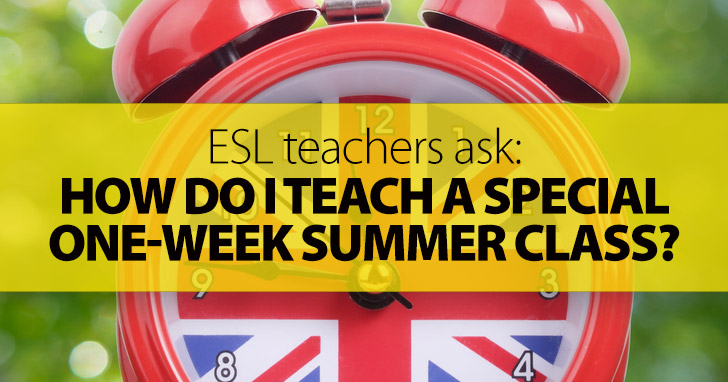"Somehow I ended up recruited to teach a summer ESL class even though I have NO IDEA what I'm doing! The class is going to be for Chinese students ages 10-16. It's only a week long - I have no clue what to do! HELP! HELP! HELP!"*
Few situations have the potential to drive ESL teachers into desperation, and the situation described above is one of them. First things first. If you have accepted to teach a special class, whether it’s a one-week class given over a long holiday break or a month-long session given over the summer, one thing is clear: you’ve accepted the job, and no amount of worrying or hair pulling will help you out. You’ve got to take the bull by the horns and plan. And here’s how:

Teach a Special One-Week Summer Class Expertly
-
1
Gather Information
In the case mentioned above, the only thing the teacher seems to know is the students’ nationality and age range. Not a whole lot to go on, I’m afraid. You’ll need to find out a lot more than that if you want to plan a week’s (or a month’s) worth of activities. These are the blanks you’ll need to fill in:
- Age (check!)
- Nationality (check!)
- Number of students (10 or 20? Not the same thing!)
- English proficiency level(s) (This one could be tricky, but more on that later)
- Purpose/Goal of the class/session
-
2
Consider Their Proficiency Levels and Ages
Lots of times, these types of winter/summer sessions are given in English-speaking countries to students who have recently arrived and don’t speak the language. I’m guessing this is the case with the Chinese students mentioned above. So, if you’re lucky, they will all be beginners and should make the class a lot easier to plan. But what happens if they have different proficiency levels? It also complicates things if they are kids in different age groups. In a group of kids between 10 and 16, you’re mixing grade-schoolers with teens! Big difference! It also stands to reason that the 15/16-year olds might have some knowledge of English while the 10-year olds probably have none.
Bottom line: if you have students in different proficiency levels and age groups, you'll have to split them up into smaller groups/teams. I’d group them based on age and not level. It’s easier for them to bond and participate in peer-based activities if they are the same age, no matter what their individual differences are.
Prepare for the Worst:
What happens if, for some reason or other, you won’t know what their proficiency level is till the first day of class? No need to panic. Make the first day a “Getting to Know Each Other” session. Have them sit in a circle and ask them questions. Make a mental note of how much each one knows. Can they answer basic questions? Say yes or no? Nothing at all? Also, see if there any students who know a bit more – they’re your best allies and may be able to help you by leading group activities. -
3
Consider the Goal/Purpose of the Class
The big question you should ask yourself is: why is this particular group of students taking this class for one week/month? Are we talking about a group of foreign businesspeople who want to prepare for a conference/trip/English-speaking event or a group of foreign children who have just arrived to the country and don’t speak a word of English? What if it’s simply a Summer Camp type of course where they just want to have fun learning English? (I’ve taught several of those!) Always have the goal topmost in your mind. It will help you decide your main plan and which activities to include to help them meet this goal.
-
4
Prepare Your Main Plan
Your main plan should be focused on helping your students achieve their main goal. Consider the number of days they have to achieve this goal and devise a series of steps or daily goals. For example, if you need to teach a group of 10-16 year olds who don’t speak English and need to know the basics to get around (main goal), think about what those basic should be and come up with a series of daily lesson plans:
- Day 1: Introduce yourself and talk about yourself (name, age, nationality)
- Day 2: Talk about likes, dislikes, preferences and routines (I live/work, speak, like, don’t like, eat, drink – simple present)
- Day 3: Making requests, saying thank you, etc...
- Day 4: Etc…
-
5
Plan Your Daily Activities
Once you know what your goal is for each day, it’s smooth sailing ahead! Depending on your students’ goal, activities should be more or less game-based. For example, in a kid’s summer course, we always had lots of games, crafts and movies, because the goal was to have fun with English. If your students need to learn basics to get around, you should add plenty of role-playing to help them practice.
-
6
Be Realistic
This is perhaps the single most important thing you should do. If you’re given one week to teach a group of students, you can’t perform any miracles. But there’s plenty you can achieve! If you focus on the daily goals you’ve set out for them, you’re setting yourself (and your students) up for success.
These are steps in an action plan and by no means guarantee there won’t be any surprises.
Be ready to shift and adjust your daily goals as specific needs arise. Focus on your students and their success, and you’ll have a summer session you'll never forget.
P.S. If you enjoyed this article, please help spread it by clicking one of those sharing buttons below. And if you are interested in more, you should follow our Facebook page where we share more about creative, non-boring ways to teach English.







